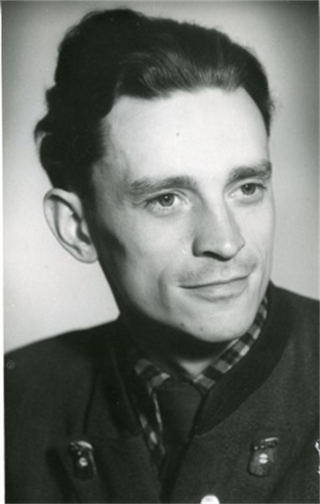Hofrat Dr. Herbert Glaser

Personalia
Born:
Died:
Profession:
Persecution:
Imprisonment 27.08.1940 - 29.01.1941,
Imprisonment 27.05.1942 - 11.06.1942
Memberships
Curriculum Vitae
Herbert Glaser is the younger brother of Karl Glaser and attended the Realgymnasium in Salzburg.
"I belong to one of those age groups that still experienced something of the First Republic, the corporative state to a large extent and the Nazi era very consciously. " - this is how Herbert Glaser describes his life in retrospect. He talks about the Anschluss as he experienced it:
"In the evening hours of March 11, 1938, the Nazi era also began for the Austrians. I was in the third year of secondary school at the time and not quite 14 years old. I personally heard the farewell speech by Federal Chancellor Dr. Schuschnigg with the decisive declaration 'We are giving way to violence' ... God bless Austria!"
Several members of the Norica student fraternity then quickly cleared out the Norica building before everything was confiscated. Former Norica member Karl Beran also takes part in this action. He takes one of the two Norica flags and ties it around his waist. In this way, it can be removed from the house undetected. Herbert Glaser then continues:
"He [Beran] brought it to Salzburg. My brother and I were asked to hide her safely here. We did so, and the venerable flag lay carefully packed for almost ten years under a discarded toilet seat and other junk until the later Minister of Finance, Dr. Wolfgang Schmitz, came to collect it from us. ... In gratitude, I was awarded the Norica ribbon in the presence of Federal Chancellor Ing. Leopold Figl and Ing. Julius Raab at a ceremony at Ulrichskirchen Castle."
After the "Reichsbund der katholisch-deutschen Jugend Österreichs" was banned, Anton Pinsker, SJ invited people to evening "Bible Rounds" in the lower church of St. Elisabeth. The weekly meetings with participants "screened" for their reliability developed into a "substitute form of a Catholic youth organization". In 1939, Herbert Glaser was put in charge of the lay leadership there.
In the spring of 1940, he met Hans Glaser, a private in the Mountain Intelligence Replacement Division No. 18, XVIII. Army Corps in Salzburg, Hans Graber (1918-1944), the co-founder of the "Austrian Home Front" resistance group.
Hans Graber writes and copies the combat journal "Hör zu" in the Riedenburg barracks in Salzburg. Alongside other members of this resistance group, 16-year-old Herbert Glaser was interrogated by the Gestapo on August 25, 1940, arrested for distributing the magazine and subsequently held in pre-trial detention in the Franciscan monastery in Salzburg, the Gestapo headquarters since October 18, 1938, until January 29, 1941. He was accused of "attempted secession of the Ostmark from the German Reich". The only evidence, however, was the passing on of a leaflet critical of the Nazis. The group was investigated and disbanded because of this leaflet.
"The organization is said to have been exposed through betrayal. I heard later that a young man had shown the pamphlet to his father. He got scared and reported it to the security service in Reichenhaller Straße. As a result, he gained immunity from prosecution."
However, no charges were brought.
"While I was under investigation for the crime of 'preparation for high treason', I spent three months in solitary confinement - also as a juvenile - and the rest of the time in a shared cell with juvenile criminals at the Salzburg provincial court."
During his imprisonment, his parents had to endure two house searches.
On May 26, 1942, Herbert Glaser was arrested again on the accusation that he was still associating with opponents of National Socialism and was held in Gestapo custody until June 6, 1942, but nothing could be proven against him.
At the end of July 1943, Herbert Glaser received a call-up order to join Gebirgs-Kraftfahrabteilung 18 in Bregenz. According to the "Reifevermerk" (1944), he was deployed in Estonia as a member of the 630 transport regiment until the fall of 1944. Due to the death of his father, a victim of the unexpected bombing of Salzburg, he was granted special leave in Salzburg in November 1944. He then received his marching orders to Schwelm near Wuppertal. There, in mid-April 1945, he went to meet the US soldiers as a member of his unit's parliament and was taken prisoner of war by the Americans on April 17, 1945. On October 16, 1945, he was released from the Displaced Persons Camp [DP] Laschenskyhof in Salzburg after various changes of camp.
After the war, Herbert studied law in Innsbruck and was accepted into the underground student fraternity Alpinia Innsbruck in 1946. In 1948, he successfully passed the 2nd state law examination at the provincial court building in Innsbruck. In the fall of 1949, he was appointed provincial party secretary of the Salzburg People's Party [ÖVP], a post he held until 1951. After being elected in 1953, he was a member of Salzburg City Council until 1972. From 1973 to 1989, he was director of the Commercial Academy I and the Commercial School. In 1949, Herbert Glaser received the Norica ribbon for rescuing one of the two Norica flags that the Glaser family had kept hidden.
Citations
Krause, Peter/Reinelt, Herbert/Schmitt, Helmut (2020): Farbe tragen, Farbe bekennen. Katholische Korporierte in Widerstand und Verfolgung. Teil 2. Kuhl, Manfred (ÖVfStG, Wien) S. 90/91.
